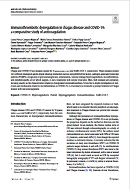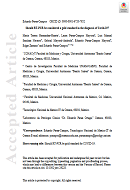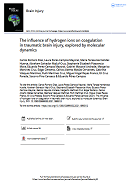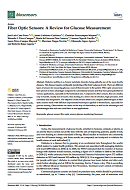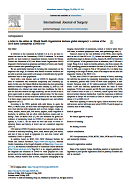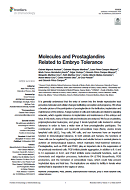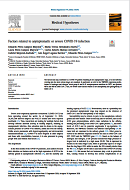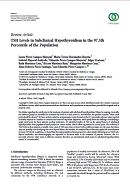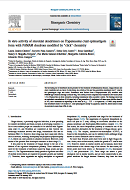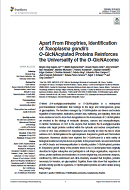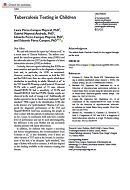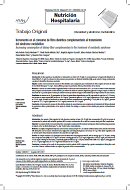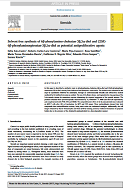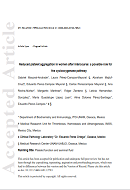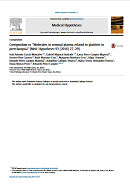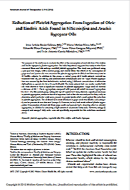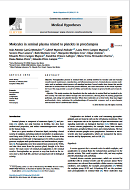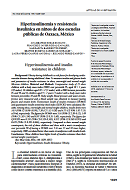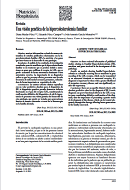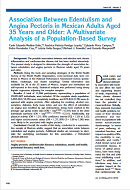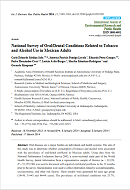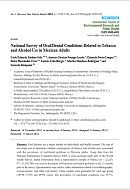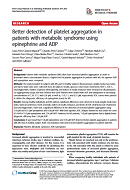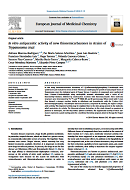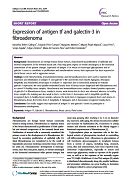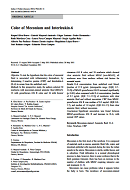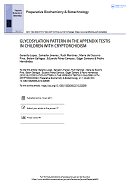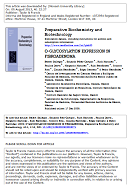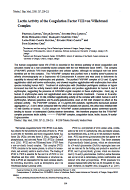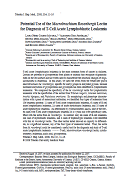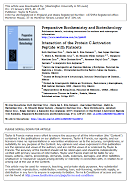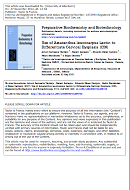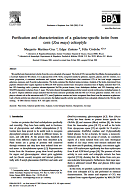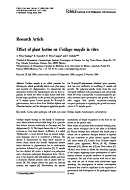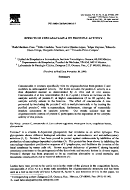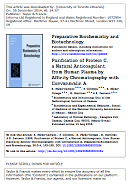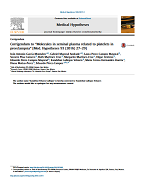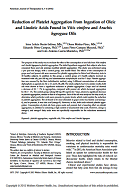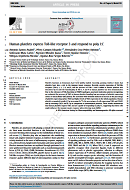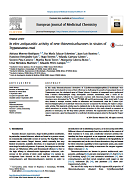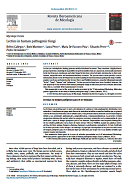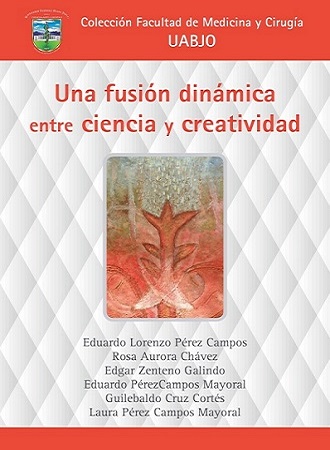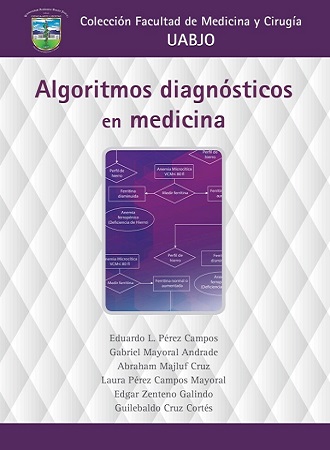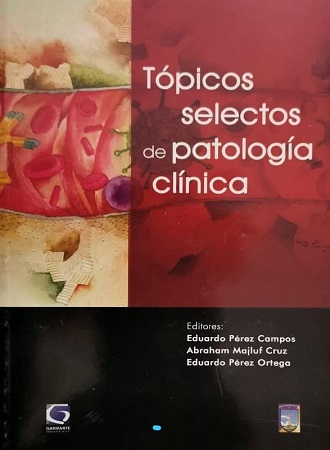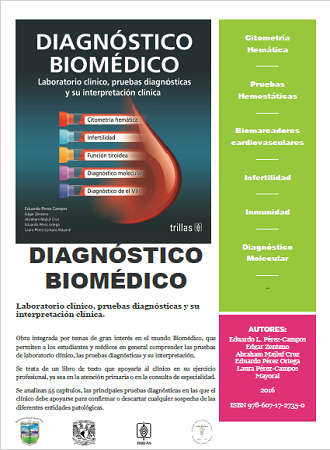| 76 |
Infección humana asintomática por contacto con perros. Un caso de ehrlichiosis humana.
|
Ángela Beatriz Silva, Socorro Pina Canseco, María del Pilar Gabriel de la Torre, Alejandro Mayoral Silva,
Miguel Ángel Mayoral, Laura Pérez-Campos Mayoral, Jael LopezMartínez, y Eduardo Pérez-Campos.
|
|

|
| 77 |
Principales razones de extracción de dientes permanentes en una muestra de adultos mexicanos.
|
Medina Solís Carlo Eduardo, Pontigo Loyola América Patricia, Pérez Campos Eduardo, Hernández Cruz Pedro,
De la Rosa Santillana Rubén, Navarete Hernández José de Jesús, Maupomé Cervantes Gerardo.
|
Resumen
Objetivo: Identificar las razones principales para extracción dental en pacientes adultos que acuden a
clínicas dentales universitarias. Material y métodos: Se realizó un estudio transversal en 331 sujetos de
entre 18 y 85 años de edad (45.37 ± 13.85) que acudieron a las clínicas dentales de la Universidad Autónoma
del Estado de Hidalgo entre enero y diciembre de 2009. Los datos sobre edad, sexo, diente y motivo para la
extracción (clasificación de Kay & Blinkhorn, 1986) se analizaron mediante pruebas no paramétricas en STATA 9.0.
Resultados: En total se realizaron 779 extracciones. La mayoría de las personas que requirieron el servicio fueron
mujeres (66.8%). La principal razón fue por caries dental (43.1%; n = 323), seguida de enfermedad periodontal
(27.9%; n = 209) y razones protésicas (21.51%, n = 161). En promedio se realizaron más extracciones entre los
pacientes de 45 a 85 años que entre los menores de 45 años (p < 0.01). No se observaron diferencias significativas
del motivo de extracción por sexo (p > 0.05). Existieron diferencias (p < 0.001) respecto al motivo de extracción
en cuanto a edad (la extracción por enfermedad periodontal se incrementó conforme la edad); pacientes con visita
única vs. aquéllos con visitas múltiples (caries en pacientes presentándose por única vez vs. enfermedad periodontal
en aquéllos con visitas múltiples). Por tipo de diente: superiores, posteriores y molares se extrajeron más por
caries mientras que inferiores, anteriores e incisivos fueron extraídos más frecuentemente por enfermedad
periodontal. Conclusiones: La caries dental fue la razón más común para la extracción de dientes, seguida por
enfermedad periodontal. Se encontraron diferencias del motivo de las extracciones por características del paciente
y del tipo de diente.
|

|
| 78 |
Association between edentulism and angina pectoris in Mexican adults aged 35 years and older: a
multivariate analysis of a population-based survey.
|
Medina-Solís CE, Pontigo-Loyola AP, Pérez-Campos E, Hernández-Cruz P, Avila-Burgos L,
Kowolik MJ, Maupomé G. J Periodontol.
|
Background: The possible association between oral infection and chronic inflammation and cardiovascular
disease risk has been studied intensively. The present study is designed to determine the strength of
association between edentulism and angina pectoris in Mexican adults aged 35 years and older.
Methods: Using the tools and sampling strategies of the World Health Survey of the World Health
Organization, cross-sectional data were collected in Mexico in the National Performance Assessment
Survey (probabilistic, multistage, and cluster sampling). Dental information was available for 20 of
the 32 states of Mexico. Angina and edentulism are self-reported in this study. Statistical analysis
was performed using binary logistic regression adjusting for complex samples.
Results: A total of 13,966 participants, representing a population of 29,853,607 individuals, were
included. Of the complete study population, 3,052,263 (10.2%) were completely toothless, and 673,810
(2.3%) were diagnosed with angina pectoris. After adjusting for smoking, alcohol consumption, diabetes,
body mass index, and sex, the effect of edentulism on angina was modified by age (interaction), being
more marked in the younger age group (odds ratio [OR] = exp(2.5597) =12.93) than in the older individuals
surveyed (OR = exp(2.5597 + (-0.0334)) =12.51). Additionally, low physical activity (OR = 1.51; 95%
confidence interval [CI] = 1.03 to 2.22) and higher socioeconomic status (OR = 1.37; 95% CI = 1.00 to 1.90)
were more likely to be associated with angina pectoris.
Conclusions: Overall, the results of this study, conducted in a representative sample of Mexican adults,
suggest that an association exists between edentulism and angina pectoris. Additional studies are necessary
to elucidate the underlying mechanism for this association.
|
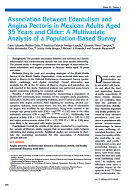
|
| 79 |
Why not change classical treatments for glioblastoma in elderly patients?
|
Eduardo Perez-Campos, Javier Arjona Perez, Laura Perez-Campos Mayoral, Itandehui Gallegos Velasco,
Pedro Hernandez Cruz, Primitivo Gonzalez Olivera.
|
In consideration of the poor results obtained with conventional treatments,
a review of alternative treatments for elderly patients with glioblastoma was
researched in this study. The proposal considers the elimination of human cytomegalovirus,
modifying the immune response, arresting growths, blocking some signaling pathways, and
modulating the effects of oxygen reactive species.
|

|
| 80 |
El papel de la galectina-3 en el desarrollo del cáncer de mama.
|
Belen Gallegos, Blanca Cuevas, Eduardo Perez Campos, Rocio Coutiño, Pedro Hernandez Cruz.
|
RESUMEN
El cáncer de mama es la segunda causa de muerte de mujeres en el mundo, sin embargo si es diagnosticado oportunamente puede ser curado. Recientemente se ha observado que cambios en la estructura de los oligosacáridos de las proteínas de membrana, se relacionan con los procesos de transformación y proliferación celular, los cuales pueden originar el cáncer de mama, además, la presencia de receptores para estos carbohidratos, puede potencializar la capacidad metastásica del tumor. En esta revisión se presenta una visión general de los marcadores glicosilados y de sus receptores, especialmente la galectina-3, que se ha asociado al cáncer de mama.
ABSTRACT
Breast cancer is the second cause of death of women in the world and when it is diagnosed opportunely can be cured. Recently it has been observed that changes in the oligosaccharides structures of membrane proteins are related to the transfor-mation processes and cellular proliferation, in addition, the presence of receptor for these carbohydrates, can potentialise the metastatic capacity of the tumor. In this revision a general overview of the glycosylated markers and their receptors, espe-cially galectin-3 that, has been associated to the breast cancer.
|
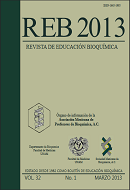
|
| 81 |
Caries dental y enfermedad periodontal: principales razones para extracción de dientes permanentes en mexicanos de 18 años y más.
|
Medina-Solís CE, Pontigo-Loyola AP, Pérez-Campos E, Hernández-Cruz P, De la Rosa Santillana R,
Navarrete-Hernandez JJ,Maupomé G.
|
Resumen
Objetivo: Identificar las razones principales para extracción dental en pacientes adultos que acuden a
clínicas dentales universitarias. Material y métodos: Se realizó un estudio transversal en 331 sujetos de
entre 18 y 85 años de edad (45.37 ± 13.85) que acudieron a las clínicas dentales de la Universidad
Autónoma del Estado de Hidalgo entre enero y diciembre de 2009. Los datos sobre edad, sexo, diente y
motivo para la extracción (clasificación de Kay & Blinkhorn, 1986) se analizaron mediante pruebas no
paramétricas en STATA 9.0.
Resultados: En total se realizaron 779 extracciones. La mayoría de las personas que requirieron el
servicio fueron mujeres (66.8%). La principal razón fue por caries dental (43.1%; n = 323),
seguida de enfermedad periodontal (27.9%; n = 209) y razones protésicas (21.51%, n = 161).
En promedio se realizaron más extracciones entre los pacientes de 45 a 85 años que entre los
menores de 45 años (p < 0.01). No se observaron diferencias significativas del motivo de extracción por
sexo (p > 0.05). Existieron diferencias (p < 0.001) respecto al motivo de extracción en cuanto a edad
(la extracción por enfermedad periodontal se incrementó conforme la edad); pacientes con visita única vs.
aquéllos con visitas múltiples (caries en pacientes presentándose por única vez vs. enfermedad periodontal
en aquéllos con visitas múltiples). Por tipo de diente: superiores, posteriores y molares se extrajeron más
por caries mientras que inferiores, anteriores e incisivos fueron extraídos más frecuentemente por
enfermedad periodontal.
Conclusiones: La caries dental fue la razón más común para la extracción de dientes, seguida por enfermedad
periodontal. Se encontraron diferencias del motivo de las extracciones por características del paciente y
del tipo de diente.
|

|
| 82 |
Expression of antigen tf and galectin-3 in fibroadenoma
|
Gallegos Belem Itandehui, Pérez-Campos Eduardo, Martinez Margarito, Mayoral Ángel Miguel, Pérez Laura,
Aguilar Sergio, Zenteno Edgar, Pina del Maria, Hernández Pedro, BMC Research Notes.
|
Background: Fibroadenomas are benign human breast tumors, characterized by proliferation of epithelial
and stromal components of the terminal ductal unit. They may grow, regress or remain unchanged, as the
hormonal environment of the patient changes. Expression of antigen TF in mucin or mucin-type glycoproteins
and of galectin-3 seems to contribute to proliferation and transformations events; their expression has
been reported in ductal breast cancer and in aggressive tumors.
Findings: Lectin histochemistry, immunohistochemistry, and immunofluorescence were used to examine the
expression and distribution of antigen TF and galectin-3. We used lectins from Arachis hypogaea,
Artocarpus integrifolia, and Amaranthus lecuocarpus to evaluate TF expression and a monoclonal antibody
to evaluate galectin-3 expression. We used paraffin-embedded blocks from 10 breast tissues diagnosed with
fibroadenoma and as control 10 healthy tissue samples. Histochemical and immunofluorescence analysis
showed positive expression of galectin-3 in fibroadenoma tissue, mainly in stroma, weak interaction in
ducts was observed; whereas, in healthy tissue samples the staining was also weak in ducts. Lectins
from A. leucocarpus and A. integrifolia specificaly recognized ducts in healthy breast samples, whereas
the lectin from A. hypogaea recognized ducts and stroma. In fibroadenoma tissue, the lectins from A.
integrifolia, A. Hypogaea, and A. leucocarpus recognized mainly ducts.
Conclusions: Our results suggest that expression of antigen TF and galectin-3 seems to participate in
fibroadenoma development.
|
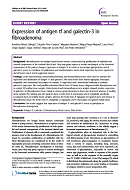
|
| 83 |
Protein C activation peptide inhibits the expression of ICAM-1, VCAM-1, and interleukin-8 induced by
TNF-? in human dermal microvascular endothelial cells.
|
Pina-Canseco Mdel S, Páez-Arenas A, Massó F, Pérez-Campos E, Martínez-Cruz R, Hernández-Cruz P,
Majluf-Cruz A, Martínez-Cruz M, Pérez-Campos Mayoral L, Pérez-Santiago AD, Zenteno E.
|
Activated protein C (APC) is generated from the cleavage of protein C by thrombin coupled to thrombomodulin
and, subsequently, is released as protein C activation peptide (papC). The aim of this study was to evaluate
the effect of papC on human dermal microvascular endothelial cells (HMEC-1), activated with 5 ng//mL TNF-α.
Flow cytometry showed that papC inhibited the expression of VCAM-1 and ICAM-1, after activation with TNF-a.
Similarly, RT-PCR analysis revealed that 2 and 4 pM papC inhibited the expression of VCAM-1 and IL-8 mRNA in
TNF-α-treated HMEC-1. In addition, the expression of endothelial nitric oxide synthase(eNOS) increased in
HMEC-1 treated with papC, compared to those without treatment. Furthermore, Jurkat cell adhesion to HMEC-1
induced by TNF-a was significantly inhibited after the addition of papC, compared to HMEC-1 without papC
(p = 0.03). Finally, a control peptide analog to papC showed no effect on the expression of ICAM and VCAM
on the surface of HMEC-1. In conclusion, our results suggest that papC exerts anti-inflammatory effects on
endothelial cells.
|

|
| 84 |
The Relationship of Aluminium and Silver to Neural Tube Defects; A Case Control.
|
Ramírez-Altamirano, M., Fenton-Navarro, P., Sivet-Chiñas, E., Harp-Iturribarria, F., Martínez-Cruz, R., Hernández Cruz, P., Martínez Cruz, M., Pérez-Campos, E.
|
|

|
| 85 |
A study on inorganic elements in psammomas from ovarian & thyroid cancer.
|
Pedro S Olivera Merlin, Paulina del C. Leyva Bohorquez, Ruth Martínez-Cruz, Socorro Pina Canseco,
Pedro Hernandez, Margarito Martínez-Cruz, Manuel Sánchez Rubio, Lucía Martínez Martínez,
Eduardo Pérez-Campos.
|
Background & objectives: Concentric lamellar calcifications known as psammoma bodies (PB) are found in
benign and malignant tumours. Whether or not the inorganic element concentrations in psammomas are
similar to serous adenocarcinoma of the ovary and thyroid papillary cancer tissues has not yet been
ascertained. We undertook this retrospective study to establish if there is any difference in the
concentrations of inorganic ions found in psammomas in serous adenocarcinoma of the ovary, and those
found in thyroid papillary cancer tissue. Methods: PB samples from patients with adenocarcinoma of the
ovary (n = 10) and with thyroid papillary cancer (n = 10) were analyzed through inductively-coupled
plasma spectroscopy (ICP). Results: There were no significant differences in the concentrations of
inorganic elements in PB from thyroid papillary cancer than in those PB from ovarian cancer.
Interpretation & conclusions: Differences in the concentrations of inorganic elements may be due to the
variation in environmental pollution. Our study had limitation of small sample size. Our results suggest
that some inorganic elements can participate in the origin of psammoma bodies.
|

|
| 86 |
Color of meconium and interleukin-6
|
Silva-Bravo R, Mayoral-Andrade G, Zenteno E, Hernandez P, Martínez-Cruz R, Mayoral LP, Aguilar-Ruiz S, Paz-Pacheco A,
Zarate-Aspiros R, López-Bravo M, Roldan-Aragon Y, Pérez-Campos E.
|
Objective: To test the hypothesis that the color of meconial fluid is associated with inflammatory
biomarkers, by determining C-reactive protein (CRP) and Interleukin-6 (IL-6) in serum from the
umbilical cord.
Methods: In this prospective study, the authors selected 30 newborns with meconium-stained amniotic
fluid (MSAF): 14 with green/brown 656 R color and 16 with brown/cinnamon 654 R color, and 20 newborns
which showed clear amniotic fluid without MSAF (non-MSAF); all newborns were from mothers without risk
factors for neonatal sepsis.
Results: IL-6 concentration from umbilical cord blood, [median of 12.9 pg/mL (interquartile range {IQR} 8.7-31.0)]
of MSAF-green/brown 656 R increased significantly (p < 0.05) when compared with IL-6 concentration,
[median of 9.2 pg/mL (IQR 7.2-12.2)] of newborns with clear amniotic fluid and without meconium. CRP
from MSAF-green/brown 656 R was median of 0.5 mg/mL (IQR 0.0-2.7), and median of 1.0 mg/mL (IQR 0.0-5.5)
from clear amniotic fluid, without meconium.
Conclusions: Significant association was found between MSAF-green/brown 656 R and increase in IL-6,
with normal CRP values.
|

|
| 87 |
Glycosylation pattern in the appendix testis in children with cryptorchidism
|
Lopez G, Jmenez S, Martinez R, Pina Mdel S, Gallegos B, Pérez-Campos E, Zenteno E, Hernández P.
|
In humans, at about week 6, sex cords develop within the forming testes. Testes normally descend to
the scrotum; cryptorchidism occurs when one or two testes do not descend to scrotum and in some case
are accompanied by the appendix testis. The appendix testis is a small sessile or polypoid structure
located at the antero superior pole of the testis, adjacent to the head of the epididymis. Glycans can
be involved in development of the appendix testis and cryptorchidism. In this work, lectin histochemistry
was used to evaluate glycans expression in appendix testis in children with cryptorchidism. Our results
showed that lectin from Lens culinaris, Ulex europaeus I., Canavalia ensiformis, Artocarpus integrifolia,
Glycine max, and Griffonia simplicifolia recognizes epithelial and estromal cells. Not interaction was
observed with lectin from Amaranthus leucocarpus, while lectin from Dolichus biflorus lectin only
recognizes epithelial cells. Our results suggest that O-glycans linked in some glycoproteins represent
important elements in appendix testis development.
|
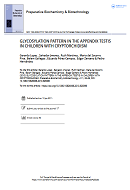
|
| 88 |
Effects of music therapy on depression compared with psychotherapy.
|
Sergio Castillo-Pérez, Virginia Gómez-Pérez, Minerva Calvillo Velasco, Eduardo Pérez-Campos, Miguel-Angel Mayoral.
|
This paper reports a study testing the effects of music on depression and compares them with the effects
of psychotherapy. There are mainly three conventional treatments for depression: psychotherapy,
pharmaceutical treatments, and electroconvulsive therapy. Because conventional treatment has proven
to be poorly successful, new means of treatment must be found that might improve depression when used
together with other therapies. A randomized controlled clinical trial was performed with a convenience
sample of 79 patients aged 25–60 years with low- and medium-grade depression. The Zung Depression
Scale was employed for selection purposes. Patients were randomly assigned to the music-therapy group
(classical and baroque music) (n = 41), or the psychotherapy group based on conductive-behavioral therapy
(n = 38). The music therapy was applied for 50 min a day, every day, for eight weeks. At the end, the
music-therapy group had less depressive symptoms than the psychotherapy group, and this was proven to be
statistically significant with the Friedman test. We propose that patients with low- and medium-grade
depression can use music to enhance the effects of psychological support.
|
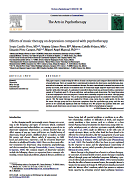
|
| 89 |
O-glycosylation expression in fibroadenoma
|
Gallegos B, Pérez-Campos E, Martinez R, Leyva P, Martinez M, Hernández R, Pina S, Hernández C, Zenteno E, Hernández P.
|
Fibroadenomas are human benign breast tumors characterized by proliferation of epithelial and stroma cells
of the terminal ductal unit. Expression of O-glycans seems to contribute to the proliferation and
transformation events. With this in mind, we evaluated the expression of glycans in fibroadenoma tissue
through immunohistochemistry with antibodies against mucin epitopes (Anti CA15-3 and MUC1), as well as
with lectins specific for glycans linked to proteins or lipids, and we compared findings with healthy
breast specimens. Our results show positive expression of CA15-3 and MUC1 in fibroadenoma tissue, mainly
in duct and stroma cells, whereas, in normal samples, staining was observed in duct cells. The lectin from
Glycine max recognized equally well duct and stroma cells; this was the only lectin showing co-localization
with anti-CA15-3 in healthy and tumor tissues. Dolichos biflorus, Artocarpus integrifolia, and Griffonia
simplicifolia lectins recognized duct cells in control healthy tissues as well as in fibroadenoma tissue.
The lectin from Amaranthus leucocarpus recognized only duct cells in control samples, whereas, in
fibroadenoma tissue, it recognized duct and some stromal cells, suggesting that O-glycans-type mucin linked
to proteins and mucin participate in the development of fibroadenomas.
|
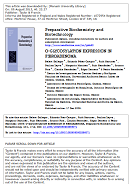
|
| 90 |
[Platelet abnormalities in type 2 diabetes mellitus]
|
Matadamas-Zárate C, Hernández-Jerónimo J, Pérez-Campos E, Majluf-Cruz A.
|
Diabetes mellitus is a problem of health worldwide being vascular complications the main causes of
morbidity and mortality in this population. Diabetics have a fast atherothrombotic evolution which
is worse than that observed for other clinical entities; however, hyperglycemia itself may not totally
explain the ischemic complications observed in these patients. Most ischemic arterial events are
precipitated by plaque rupture, platelet activation, and thrombosis. Several abnormalities in the blood
coagulation system have been described associated to diabetes mellitus, all of them predisposing to
thrombosis: endothelial cell dysfunction, platelet hyperreactivity, thrombin generation and
hypofibrinolysis. Platelets play a key role in diabetic atherothrombosis due to platelet hypersensitivity
to physiological agonists, low response to therapeutical antiplatelet agents, platelet hyperreactivity
in sites of endothelial cell damage, hyperaggregability, resistance to the inhibitory effects of the
insulin, and low endothelial production of prostacyclin and nitric oxide. All these phenomena have been
associated to either a toxic microenvironment due to hyperglycemia or to intrinsic platelet abnormalities.
Based on all these facts, it is proposed that platelets may be another target for the negative effects of
insulin-resistance state. Because platelets are crucial in the atherosclerotic process and in the genesis
of the vascular complications of diabetes mellitus, this review analyses the platelet abnormalities
observed in this metabolic disease.
|

|
| 91 |
Lectin activity of the coagulation factor VIII/von Willebrand complex
|
Santizo F, Zenteno E, Pina-Canseco S, Hernandez-Cruz P, Cruz MM, Mayoral LP, Pérez-Campos E, Martínez-Cruz R.Tohoku J Exp Med.
|
The human coagulation factor VIII (FVIII) is essential in the intrinsic pathway of blood coagulation and
circulates mainly as a non-covalently bound complex with the von Willebrand factor (VWF). This complex
(FVIII/VWF) protects FVIII from degradation and cellular uptake, although no biological role has been
identified yet for this complex. The FVIII/VWF complex was purified from a healthy donor's plasma by
affinity chromatography on a Sepharose 4B-Concanavalin A column and was used to determine its capability
to interact with erythrocytes and platelets. The purified FVIII/VWF complex at 6.0 and 12 microg/ml
agglutinates rabbit and bovine erythrocytes, and showed negative agglutination with erythrocytes from other species including human ABO. Treatment of erythrocytes with Clostridium perfringens sialidase or trypsin increased four-fold the activity toward rabbit erythrocytes and positive agglutination for human A and B erythrocytes, suggesting the presence of FVIII/VWF-cryptic receptors in these erythrocytes. Goat, pig, or human O erythrocytes were not agglutinated even after enzymatic treatment. Fucose or N-acetyl-glucosamine (GlcNAc), at 10 mM, inhibited agglutinating activity of the complex with rabbit, human A and B erythrocytes, whereas galactose and N-acetyl-galactosamine, even at 200 mM, showed no effect on the complex activity. The FVIII/VWF complex, at 1.5 microg/200,000 platelets, significantly decreased platelet aggregation (p < 0.001) when compared with the effect of platelet-rich plasma; this effect was inhibited with 15 mM GlcNAc or fucose. ELISA assays on FVIII/VWF coated polystyrene plates confirmed specific binding to fucose- or biotinylated GlcNAc-dextran derivatives. We therefore propose that the FVIII/VWF complex possesses lectin activity.
|

|
| 92 |
Potential use of the Macrobrachium rosenbergii lectin for diagnosis of T-cell acute lymphoblastic leukemia
|
Pérez-Campos-Mayoral L, Ruiz-Argüelles A, Pérez-Romano B, Zenteno E, Hernández-Cruz P, Martínez-Cruz R, Martínez-Cruz M, Pina-Canseco S, Pérez-Campos E.Tohoku J Exp Med.
|
T-cell acute lymphoblastic leukemia is the most common form of cancer in children. Lectins are proteins or
glycoproteins from plants or animals that recognize oligossacharides on the cell surface and have been
used to characterize the structural changes of oligosaccharides in leukemias. In this study, we used the
lectin from the freshwater prawn Macrobrachium (M. rosenbergii), specific for acetyl groups in sialylated
glycans, because increased sialylation of glycoproteins and glycolipids has been identified in
lymphoblastic leukemias. We compared the specificity of the M. rosenbergii lectin for lymphoblastic
leukemias with the specificities of the lectins from Triticum vulgaris, Solanum tuberosum, Arachis
hipogaea, and Phytolacca americana. By morphologic and phenotype characterization with a panel of
monoclonal antibodies, we identified four types of leukemias from 106 leukemia patients: 11 cases of
T-cell acute lymphoblastic leukemia, 61 cases of B-cell acute lymphoblastic leukemia, 24 cases of
acute myeloblastic leukemia, and 10 cases of acute biphenotypic leukemia. As determined by
cytofluorometric assays, nine of the eleven cases with T-cell acute lymphoblastic leukemia (8 +/- 3
years old) were specifically identified with the lectin from M. rosenbergii. In contrast, only six
cases of B-cell leukemia, one case of myeloblastic leukemia, and 2 cases of biphenotypic leukemia were
identified with this M. rosenbergii lectin. The other lectins tested showed no capacity to differentiate,
in a significant manner, any of the four types of leukemias tested. Thus, the lectin from M. rosenbergii
could be considered a useful tool for the diagnosis and study of T-cell acute lymphoblastic leukemia.
|
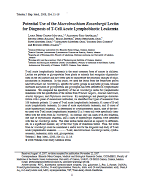
|
| 93 |
Role of concanavalin A lectin in recognition of pterygium remnant after surgical excision:
preliminary results of a prospective study
|
Díaz-González JA, Mayoral-Chávez MA, Bohórquez PL, de la Torre Mdel P, Hernández-Cruz P, Martínez-Cruz R, Pérez-Campos E.
|
Background: Pterygium is one of the most common conjunctival diseases among ophthalmic pathologies. The frequency of recurrences is high, either after surgical treatment or after treatment combined with mitomycin C or beta-radiation therapy.
Aims: The purpose of this study was to determine whether concanavalin A (ConA) lectin bound to the pterygial surface can be used to detect recurrence or remnants of pterygium after surgical excision.
Materials and methods: This was a prospective study on 20 patients with pterygium, divided in five stages, pre-surgery, early post-surgery (24h), late post-surgery (seven days), very late post-surgery (four weeks) and two months after the procedure. A drop of fluorescein-marked Con A (35 microg/mL) was instilled in the lower conjunctival eyelid sac and the eye was exposed to the light of a Wood's lamp for an average of five seconds.
Results: Out of the 20 patients, eight patients were found to have fluorescent stretch marks over the scar corresponding to residual pterygial tissue at four weeks; two months after the procedure of re-surgery we observed no fluorescent remnants. All residual pterygia were confirmed through histochemistry studies.
Conclusion: It was possible to detect remnants of pterygium in postoperative patients and recurrences in early pre-clinical stages through the visualization of fluorescent ConA bound to the pterygial surface.
|

|
| 94 |
Use of amaranthus leucocarpus lectin to differentiate cervical dysplasia (CIN)
|
|
Alterations in O-glycosylation of proteins in cell surfaces can originate disorder in cellular function,
as well as in cell transformation and tumoral differentiation. In this work, we investigate changes in
O-glycosylation in cervical intraepithelial dysplasia (CIN) at different stages of differentiation
(CIN I, CIN II, and CIN III) using lectins specific for O-glycosidically linked glycans. Twenty cases
with CIN I, CIN II, and CIN III dysplasias each, and 20 normal cases were studied by lectin histochemistry
and evaluated under optical microscopy. The lectins from Glycine max and Griffonia simplicifolia showed
no differences in their recognition pattern among the different CIN stages and normal tissue. Dolichos
Biflorus lectin recognized CIN I dysplasia. Lectin from Amaranthus leucocarpus showed increased reactivity
in the presence of CIN II dysplasia, compared with CIN I and CIN III. These results suggest that subtle
modifications in the O-glycosylation pattern could be considered in diagnosis or prognosis of cervical precancerous stages.
|
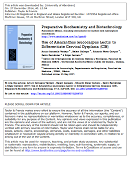
|
| 95 |
Interaction of the protein C activation peptide with platelets.
|
Martínez-Cruz R, Canseco Mdel S, Lopez-Martínez J, Cruz PA, Pérez-Campos E, Cruz MM, Alva FC, Majluf-Cruz A, Zenteno E, Ruiz-Argüelles A.
|
The peptide NH(2)-DTEDQEDQVDPR-COOH is released during activation of protein C zymogen. We measured the effect of a synthetic peptide with an amino acid sequence similar to that of the natural peptide on platelets from healthy individuals using platelet aggregometry. We found that this synthetic peptide inhibits platelet aggregation induced by thrombin; furthermore, it diminishes mobilization of intraplatelet calcium. Molecular docking showed weak interaction between the synthetic peptide and thrombin. Our findings suggest that this synthetic peptide may interact with a receptor located on the platelet cell membrane.
|
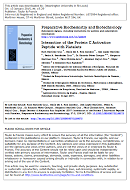
|
| 96 |
Detección de drogas de abuso en orina y sus adulterantes
|
Laura Pérez-Campos-Mayoral, Eduardo Pérez-Campos Mayoral, Ruth Martínez-Cruz, Eduardo Pérez-Campos.
|
Se hace una revisión sobre las pruebas para detectar drogas de abuso en orina, la evolución de los puntos de corte, la sensibilidad de los inmunoensayos, el tipo de anticuerpos que se emplean en estos análisis, y los adulterantes más comunes que se usan para enmascarar una prueba positiva.
|

|
| 97 |
Identificación forense de fluido seminal.
|
Gabriel Mayoral Andrade, Eduardo Pérez-Campos-Mayoral, Lucia Martínez Martínez, Pedro Hernández Cruz, Eduardo Pérez-Campos.
|
Presentamos una revisión de los métodos empleados para detectar e identificar el fluido seminal, como es
el examen microscópico, detección de fosfatasa ácida y el antígeno prostático específico. Adicionalmente
comentamos respecto a las técnicas basadas en el DNA para la identificación de individuos.
|

|
| 98 |
Métodos para detectar restos de disparos de armas de fuego
|
Eduardo Pérez-Campos-Mayoral, Flor De Ma. Harp I, Pedro Hernández-Cruz, Gabriel Mayoral Andrade,
Eduardo Pérez-Campos.
|
En este artículo se hace una revisión de los métodos de laboratorio que se han empleado para detectar que una persona ha disparado un arma de fuego, haciendo referencia a la prueba de la parafina, del rodizonato de sodio, de espectroscopía de emisión por plasma, absorción atómica, y microscopía electrónica de barrido entre las más importantes.
|

|
| 99 |
[Inductive coupled plasma spectroscopy study of trace elements in gallstones from different regions of Oaxaca State]
|
Martínez-Luna MS, Guzmán-Ortiz D, Herrera-Colmenares E, Flores Samaniego B, Martínez-Cruz R, Pérez-Campos E.
|
|

|
| 100 |
[Prevalence of non-alcoholic esteatohepatitis in adults with metabolic syndrome in Oaxaca]
|
Alvarez-Martínez HE, Pérez-Campos E, Leyva-Bohórquez P.
|
Nonalcoholic steatohepatitis (NASH) is a chronic liver disease that occurs in patients with no significant alcohol consumption, characterized for macrovesicular steatosis, hepatocellular necrosis, mixed inflammatory infiltrate and various grades of fibrosis and, in some cases, Mallory bodies. The prevalence of this disease is unknown; recent studies indicate that in the general population, incidence is about 3%, although the rates are higher in some subpopulations as are obesity and diabetes mellitus. The goal of this work was to determine the prevalence of non-alcoholic steatohepatitis in one sample of patients with the metabolic syndrome, patients at "Presidente Juárez" Regional Hospital. It was a cross-sectional and descriptive study in which, by means of random selection a sample of 110 patients with type 2 diabetes mellitus, arterial hypertension, obesity and dyslipidemia, alone or in combination was chosen. We carried out a clinical and laboratory evaluation, selecting those patients with persistent elevation of aminotransferases for whom additional studies were made, in order to exclude other causes of enzyme abnormality. Five patients were selected for percutaneous liver biopsy, all they had NASH. The prevalence of NASH was 4.54%. The clinical and laboratory characteristics of these patients will be discussed in the article.
|

|
| 101 |
[Causality in medicine]
|
Alvarez-Martínez H, Pérez-Campos E.
|
The concept of causality is a part of every day life because man has always searched for the why of things as a way of dealing with and adapting to the world. In medicine, one of the central aims of study is identification of the factors or agents that cause disease with the intention of establishing treatments and especially, to apply preventive strategies. In this work, we conducted a brief review of the philosophical positions on causality, its biological models, as well as the tools used in clinical epidemiology to evaluate causal associations.
|

|
| 102 |
[Pathogenic molecular mechanisms in non-alcoholic steatohepatitis]
|
Alvarez-Martínez HE, Montaño-Estrada LF, Hernández-Cruz P, Pérez-Campos E.
|
Non-alcoholic steatohepatitis is a chronic disease that occurs in persons without significative
consumption of alcohol, characterized by macrovesicular steatosis, mixed inflammatory infiltrate,
and diverse degrees of fibrosis. It can progress to cirrhosis and its evolution to hepatocellular
carcinoma has been described. It principally occurs in patients with obesity, diabetes mellitus,
and hyperlipidemia, and is at present considered a manifestation of metabolic syndrome with insulin
resistance. In pathogenesis, diverse factors, fundamentally insulin resistance as a mechanism that
determines hepatic steatosis, have been described. Later, alteration of signalling cascades, oxidative
stress, and other mechanisms occur that lead to inflammation, necrosis, and finally to hepatic fibrosis,
the details of which will be described in this review.
|

|
| 103 |
[Bone mineral density and 17 beta-estradiol correlation in postmenopausal women]
|
Cárdenas Morales BE, Pérez Campos E, Gatica Valdez N.
|
Background: With the increased life-expectancy reached during 20th century, women will spend a very important part of their lives in the estrogenic deficiency state accompanying menopause.
Objectives: To detect serum 17beta-estradiol levels, bone mineral density values, and to see the correlation between both parameters as well as with postmenopausal period.
Material and methods: A transversal study with ambulatory, community-dwelling postmenopausal women from Oaxaca de Juárez, Oax. was performed.
Results: We studied 70 women with spontaneous menopause, medium values were: age, 55.9 +/- 5.4 yr; menopause age, 48 +/- 3 yr; postmenopausal period, 7.9 +/- 5.3 yr; body mass index, 28.3 +/- 5.4, and serum 17beta-estradiol by radioimmunoassay, 62.78 +/- 25.83 pg/mL. Quantitative calcaneous ultrasound was used to measure bone mineral density and we found 30 women with normal level (-1.0 to 1.4 SD), 29 with osteopenia (-1.1 to -2.3 SD) and only 2 subjects with osteoporosis (-2.7 to 2.8 SD).
Conclusions: Statistical analysis shows that bone mineral density and postmenopausal period were significantly correlated (p<0.05) as well as serum 17beta-estradiol levels with postmenopausal period; nevertheless, no correlation between bone mineral density and serum 17beta-estradiol or body mass index (p>0.05) was found. On the other hand, it is remarkable high serum 17beta-estradiol levels found in this group, related with postmenopausal status. These latter results are different from those reported in the literature.
|

|
| 104 |
[A new thrombophilia risk factor: the increase of plasma factor VIII]
|
Hernández-Jerónimo J, Pérez-Campos E, Matadamas C, Majluf-Cruz A.
|
Factor VIII (FVIII) is key component of the fluid phase of the blood coagulation system. Recent evidence
suggests a direct relationship between high plasma levels of FVIII and an increased risk for arterial and
venous thrombosis. Thus material reviews the most important clinical and epidemiological evidence about
this prothrombotic association. Main function of FVIII is to activate FX functioning as a cofactor for
activated FIX in the presence of phospholipids and calcium. Since its deficiency has been historically
associated with a hemorrhagic disease (namely hemophilia A), it was never studied its role in thrombosis.
In order to explain the association FVIII and thrombosis, defects in its synthesis that increase its
plasma concentration as well as postranslational modifications that allow a higher activity, have been
proposed. Since 1977 it was suggested that increased plasma concentrations of FVIII and thrombosis may
be associated. Shortly after, several other studies confirmed this association. Indeed, patients with
stroke of acute myocardial infarction having high plasma levels of FVIII have a shorter survival. On the
other hand, deep venous thrombosis is more frequent in patients with high plasma levels of FVIII. This
rise in plasma FVIII concentration is also associated with recurrent venous thrombosis. The increment of
plasma FVIII concentration is not due to an acute phase reaction. Plasma concentrations of FVIII above
100-150 IU/dL increase 3-fold the risk of thrombosis while concentrations above 150 IU/dL increase the
the same risk 6-fold. While it is established the real importance of FVIII as a cause of thrombosis,
every patient at risk of thrombosis must have a quantification of this factor. Evaluation of plasma
FVIII concentration must be performed in patients with suspected thrombophilia since there is evidence
that shows that high plasma FVIII levels is an independent thrombophilic risk factor. There are not
effective therapeutic interventions able to normalize the high concentrations of FVIII. Therefore,
appropriate prophylaxis during high thrombosis risk clinical episodes is the best alternative for the
patient.
|

|
| 105 |
[Bibliographic review. The role of hypoestrogenism in postmenopausal osteoporosis--new perspectives]
|
Cárdenas Morales BE, Pérez Campos E.
|
Estrogen deficiency following menopause results in a significative bone loss, which is thought to be the result of an imbalance in bone remodeling process between formation activity and resorption, where the later is functionally higher than normal and could develop osteopenia or osteoporosis type I. Although it has been made a lot of scientific investigations to explain the way by hypoestrogenism affect skeleton, the renal mechanism remains unclear and it seems to be multifactorial. Therefore, the purpose of this review is to analyze the new perspectives about the effects of serum estradiol levels on bone tissue; special emphasize is made concerning the role of: estrogen receptors, cytokines, RANKL/RANK/OPG system, PTH and PTHrP, bone turnover markers, osteocytes apoptosis, estrogens serum levels and its metabolic pathways.
|

|
| 106 |
Analysis of the lectins from teosinte (Zea diploperennis) and maize (Zea mays) coleoptiles
|
Martínez-Cruz M, Pérez-Campos E, Zenteno E, Córdoba F.
|
To identify molecular evidence of the common origin of maize and teosinte, a lectin from teosinte
coleoptile (TCL) was purified, through affinity chromatography on a lactosyl-Sepharose column, and
some of the physicochemical parameters were compared with those from the maize coleoptile lectin (CCL).
TCL is a 92 kDa glycoprotein constituted mainly by aspartic, glutamic, glycine, leucine, and lysine
residues; in minor proportion, methionine and cysteine were also found. The glycannic portion of the
lectin, which corresponds to 10% w/w, is composed by Gal, Man, and GlcNAc. CCL is an 88.7 kDa glycoprotein
that contains 12% sugars by weight; its sugar and amino acid compositions are similar to those of TCL.
TCL is formed by two isoforms identified through acidic electrophoresis, whereas CCL is constituted by a
single molecular form. The NH(2) termini of both TCL isoforms are blocked, but their amino acid sequences
determined from tryptic peptides by matrix-assisted laser desorption ionization time-of-flight) indicated
that TCL isoforms have no homology with other mono- or dicotyledonous lectins, including CCL. TCL, just as
CCL, showed hemagglutinating activity toward animal erythrocytes, including human A, B, and O. Hapten
inhibition assays indicated that although TCL shows broader sugar specificity than CCL, it recognizes Gal
in O- and N-glycosidically linked glycans. Both lectins are equally well recognized by antibodies against
TCL.
|
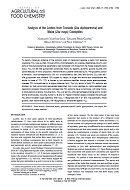
|
| 107 |
Chemical characterization of root exudates from rice (Oryza sativa) and their effects on the chemotactic response of endophytic bacteria
|
Macario Bacilio-Jiménez, Sara Aguilar-Flores, Elsa Ventura-Zapata, Eduardo Pérez-Campos, Stephane Bouquelet and Edgar Zenteno.
|
Root exudates represent an important source of nutrients for microorganisms in the rhizosphere and seem to
participate in early colonization inducing chemotactic responses of rhizospheric bacteria. We characterized
the root exudates collected from rice plantlets cultured under hydroponic conditions and assessed their
effects on the chemotaxis of two strains of endophytic bacteria, Corynebacterium flavescens and Bacillus
pumilus, collected from the rice rhizosphere. We compared these chemotactic effects on endophytic bacteria
with those on two strains of plant-growth-promoting bacteria, Azospirillum brasilense (isolated from the corn
rhizosphere) and Bacillus sp. (from the rice rhizosphere). The root exudates were collected at different time
intervals. The highest concentration and diversity of amino acids and carbohydrates were found during the first
2 weeks after seeding. Histidine, proline, valine, alanine, and glycine were the main amino acid residues
identified during the 4 weeks of culture. The main carbohydrates identified were glucose, arabinose, mannose,
galactose, and glucuronic acid. The chemotactic responses of the analyzed endophytic bacteria to root exudates
were 3.9 to 5.1 times higher than those of A. brasilense and 2.2 to 2.8 times higher than Bacillus sp. Our
results indicate that rice exudates may induce a higher chemotactic response for endophytic bacteria than for
other bacterial strains present in the rice rhizosphere.
|

|
| 108 |
Efecto de la concanavalina a en el cultivo del fitopatógeno Ustilago maydis.
|
Elsa Saavedra Hernández, Alma Pérez Santiago, Eduardo Pérez Campos, Félix Córdoba Alva.
|
|

|
| 109 |
[Non-alcoholic steatohepatitis].
|
Alvarez-Martínez H, Pérez-Campos E.
|
Non-alcoholic steatohepatitis (NASH) is a chronic liver disease that occurs in patients with no
significant alcohol consumption; it is not histologically different from alcoholic hepatitis because
it presents macrovesicular steatosis, hepatocellular necrosis, mixed inflammatory infiltrate, and
various stages of fibrosis in addition Mallory bodies in some patients. Some authors have even
described NASH as a benign disease; however, it is presently considered a potentially serious
disease that may evolve into liver cirrhosis and probably, liver cancer. It is more often related
to female sex, obesity, and dyslipidemia, although it may be present in other population groups and
associated with other factors. Its origin may be multifactorial, including insulin resistance, protein
glycation, oxidative stress, and others. The disease may be asymptomatic and found in routine physical
exams when the patient shows increased aminotransferases with no other explanation. At present the only
specific diagnosis procedure is liver biopsy. The sole available current treatment is body weight
control, normalizing glucose and lipid blood levels, as well as the administration of some medication,
as illustrated in the subsequent article.
|

|
| 110 |
Effect of plant lectins on Ustilago maydis in vitro
|
Santiago AP, Saavedra E, Pérez Campos E, Córdoba F.
|
Ustilago maydis is an edible parasitic basidiomycete, which specifically infects corn (Zea mays) and
teocintle (Z. diploperennis). To characterise the interaction between the basidiomycete and its host
organism, we tested the effect of plant lectins with well-known sugar specificity on the growth and
germination of U. maydis spores. Lectins specific for N-acetyl-D-galactosamine, such as those from
Dolichos biflorus and Phaseolus lunatus, and the wheatgerm agglutinin specific for N-acetyl-D-glucosamine
inhibited spore germination, but were ineffective in modifying U. maydis cell growth. The galactose-specific
lectin from the corn coleoptyle inhibited both germination and cell growth, while the lectin concanavalin
A (mannose/glucose specific) activated spore germination and growth. Our results suggest that specific
saccharide-containing receptors participate in regulating the growth and maturation of U. maydis spores.
|
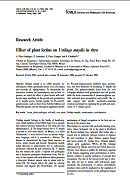
|
| 111 |
Factor tisular en células mononucleares y resistencia a la proteína C en pacientes con preeclampsia.
|
Ruth Martínez Cruz, Miguel Ángel Mayoral Chávez, Gabriel Mayoral Andrade, Félix Córdoba Alva, Rodolfo Mayoral Figueroa, Eduardo Pérez Campos.
|
Hay evidencia de la presencia de alteraciones en la coagulación que pueden agravar el estado de
preeclampsia. Por una parte se ha involucrado a las células mononucleares y por tanto a la generación de
factor tisular y por otra a la resistencia a la proteína C como mecanismos en la etiopatogenia de
problemas trombóticos. El objetivo del presente trabajo fue evaluar estos factores en una muestra de
20 mujeres embarazadas con preeclampsia y 20 mujeres embarazadas sanas. Estadísticamente no se
encontraron diferencias con relacion a uno y otro grupo, con la salvedad de 2 mujeres del grupo con
preeclampsia que mostraron resistencia a la proteína C.(AU).
|

|
| 112 |
Effects of concanavalin A on protein-C activity
|
Martínez-Cruz R, Córdoba F, Mireles-López JC, Zenteno E, Pérez-Ortega E, Martínez M, Pérez-Campos E.
|
Concanavalin A interacts specifically with the oligosaccharides from protein-C and modifies its anticoagulant activity. The lectin activates the protein-C activity in a dose dependent manner as demonstrated by in vitro and in vivo assays. Concanavalin A at low concentration (0.1 to 2 microg/mL) induces an increase on the catalytic activity of protein-C; at higher concentrations (5 to 20 microg/mL), the catalytic activity returns to the baseline. The effect of concanavalin A was prevented by incubating the protein-C with alpha-methyl-mannoside or by treating the purified protein-C with alpha-mannosidase; furthermore, cleavage of mannosidic residues diminishes its catalytic activity. Our results indicate that the oligomannosidic portion of protein-C participates in the regulation of the catalytic activity of this protein.
|
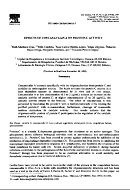
|
| 113 |
El macrófago en la vía de la hemostasia.
|
Eduardo Perez-Campos, Félix Córdoba Alva, Eduardo Pérez Ortega.
|
|
|
| 114 |
Erythroagglutinin from Phaseolus coccineus Var. Alubia: Chemical Characterization, Sugar Specificity, and Effect on Blood Coagulation Factors.
|
Eduardo Pérez-Campos,Ricardo Lascurain,Claudia Sierra, Blanca Espinosa,Henri Debray, Stephane Bouquelet, and, and Edgar Zenteno.
|
Purification of the erythroagglutinin from Phaseolus coccineus var. Alubia was achieved by affinity chromatography on human α1-acid glycoprotein and by ion exchange chromatography. The lectin is a tetrameric glycoprotein of 31 kDa/subunit with 8% sugar by weight, which agglutinates erythrocytes without serological specificity and is devoid of mitogenic activity toward human peripheral lymphocytes. The specificity of the erythroagglutinin is directed toward the Gal (β1−4) or (β1−3) GlcNAc (β1−2) Man (α1-) saccharidic sequence present in bi- or triantennary N-acetyllactosamine-type N-glycopeptides or related glycans. Alubia erythroagglutinin inhibits the generation of human thrombin, very probably by protecting prothrombin from enzymatic cleavage.
|

|
| 115 |
[Recent advances in thrombophilia]
|
Córdoba Alva F, Pérez Campos E.
|
|

|
| 116 |
Purification of protein C a natural anticoagulant, from human plasma by affinity chromatography with Convanavalin A
|
Pérez-Campos E, Córdoba F, Pérez-Ortega E, Martínez M, Zenteno E.
|
We have developed a rapid, efficient, and inexpensive method to purify protein C from plasma using
Concanavalin A conjugated to Sepharose. With this method we have obtained protein C purified to
homogeneity, as measured in polyacrylamide gels. We discuss each of the steps of our method and
give the results of the purification.
|
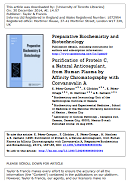
|
| 117 |
Inhibition of protein C activity with plants lectins in vitro.
|
Pérez-Campos E, Pérez Ortega E, Felix Córdoba A, Zenteno E.
|
|
|
| 118 |
Bioquímica de la proteína C de la coagulación.
|
Pérez-Campos E, Pérez Ortega E, Felix Córdoba A, Zenteno E.
|
Revista Iberoamericana De Trombosis Y Hemostasia. 1994; 7: 131-135.
|
|
| 119 |
Glycosidic interactions and the function of the coagulation factor oligosaccharides.
|
Pérez-Campos E, Pérez Ortega E, Felix Córdoba A, Zenteno E.
|
Revista Iberoamericana De Trombosis Y Hemostasia 1994;7:144-145.
|
|
| 120 |
Investigación de Blastocystis hominis en heces.
|
Pérez Campos E, Pérez Ortega E.
|
Revista Mexicana De Patología Clínica. 1990;37(3), 37-39.
|
|
| 121 |
Investigación de antígenos HIV en grupos de riesgo.
|
Pérez Ortega Eduardo, Pérez Campos Eduardo.
|
Infectología 1988;8 (9):437-440.
|
|
| 122 |
Mechanisms of Immunothrombosis by SARS-CoV-2. Biomolecules.
|
Hernández-Huerta MT, Pérez-Santiago AD, Pérez-Campos Mayoral L, Sánchez Navarro LM, Rodal Canales FJ, Majluf-Cruz A, Matias-Cervantes CA, Pérez-Campos Mayoral E, Romero Díaz C, Mayoral-Andrade G, Martínez Cruz M, Luna Ángel J, Pérez-Campos E.
|
SARS-CoV-2 contains certain molecules that are related to the presence of immunothrombosis. Here, we review the pathogen and damage-associated molecular patterns. We also study the imbalance of different molecules participating in immunothrombosis, such as tissue factor, factors of the contact system, histones, and the role of cells, such as endothelial cells, platelets, and neutrophil extracellular traps. Regarding the pathogenetic mechanism, we discuss clinical trials, case-control studies, comparative and translational studies, and observational studies of regulatory or inhibitory molecules, more specifically, extracellular DNA and RNA, histones, sensors for RNA and DNA, as well as heparin and heparinoids. Overall, it appears that a network of cells and molecules identified in this axis is simultaneously but differentially affecting patients at different stages of COVID-19, and this is characterized by endothelial damage, microthrombosis, and inflammation
|

|
| 123 |
Interaction of Spike protein and lipid membrane of SARS-CoV-2 with Ursodeoxycholic acid, an in-silico analysis.
|
Rodal Canales FJ, Pérez-Campos Mayoral L, Hernández-Huerta MT, Sánchez Navarro LM, Matias-Cervantes CA, Martínez Cruz M, Cruz Parada E, Zenteno E, Ramos-Martínez EG, Pérez-Campos Mayoral E, Romero Díaz C, Pérez-Campos E.
|
Numerous repositioned drugs have been sought to decrease the severity of SARS-CoV-2 infection. It is known that among its physicochemical properties, Ursodeoxycholic Acid (UDCA) has a reduction in surface tension and cholesterol solubilization, it has also been used to treat cholesterol gallstones and viral hepatitis. In this study, molecular docking was performed with the SARS-CoV-2 Spike protein and UDCA. In order to confirm this interaction, we used Molecular Dynamics (MD) in “SARS-CoV-2 Spike protein-UDCA”. Using another system, we also simulated MD with six UDCA residues around the Spike protein at random, naming this “SARS-CoV-2 Spike protein-6UDCA”. Finally, we evaluated the possible interaction between UDCA and different types of membranes, considering the possible membrane conformation of SARS-CoV-2, this was named “SARS-CoV-2 membrane-UDCA”. In the “SARS-CoV-2 Spike protein-UDCA”, we found that UDCA exhibits affinity towards the central region of the Spike protein structure of − 386.35 kcal/mol, in a region with 3 alpha helices, which comprises residues from K986 to C1032 of each monomer. MD confirmed that UDCA remains attached and occasionally forms hydrogen bonds with residues R995 and T998. In the presence of UDCA, we observed that the distances between residues atoms OG1 and CG2 of T998 in the monomers A, B, and C in the prefusion state do not change and remain at 5.93 ± 0.62 and 7.78 ± 0.51 Å, respectively, compared to the post-fusion state. Next, in “SARS-CoV-2 Spike protein-6UDCA”, the three UDCA showed affinity towards different regions of the Spike protein, but only one of them remained bound to the region between the region's heptad repeat 1 and heptad repeat 2 (HR1 and HR2) for 375 ps of the trajectory. The RMSD of monomer C was the smallest of the three monomers with a value of 2.89 ± 0.32, likewise, the smallest RMSF was also of the monomer C (2.25 ± 056). In addition, in the simulation of “SARS-CoV-2 membrane-UDCA”, UDCA had a higher affinity toward the virion-like membrane; where three of the four residues remained attached once they were close (5 Å, to the centre of mass) to the membrane by 30 ns. However, only one of them remained attached to the plasma-like membrane and this was in a cluster of cholesterol molecules. We have shown that UDCA interacts in two distinct regions of Spike protein sequences. In addition, UDCA tends to stay bound to the membrane, which could potentially reduce the internalization of SARS-CoV-2 in the host cell.
|

|

